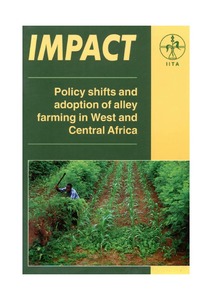| dc.contributor.author | Adesina, A.A. |
| dc.contributor.author | Coulibaly, O. |
| dc.contributor.author | Manyong, Victor M. |
| dc.contributor.author | Sanginga, N. |
| dc.contributor.author | Mbila, D. |
| dc.contributor.author | Chianu, J. |
| dc.contributor.author | Kamleu, D.G. |
| dc.date.accessioned | 2019-12-04T11:22:16Z |
| dc.date.available | 2019-12-04T11:22:16Z |
| dc.date.issued | 1999 |
| dc.identifier.citation | Adesina, A., Coulibaly, O., Manyong, V., Sanginga, N., Mbila, D., Chianu, J. & Kamleu, D.G. (1999). Policy shifts and adoption of alley farming in West and Central Africa, Impact series. Ibadan, Nigeria: IITA, (p. 21). |
| dc.identifier.isbn | 978 131 170 3 |
| dc.identifier.uri | https://hdl.handle.net/20.500.12478/3976 |
| dc.description.abstract | Alley farming is an improved fallow technology developed at the International Institute of Tropical Agriculture (IITA) as a sustainable alternative to slash-and-burn systems practiced by farmers in sub-Saharan Africa. Constraints to the use of the technology have been examined, but studies are limited which quantitatively assess determinants of farmers' adoption, and the financial profitability of alley farming under alternative policies. The objectives of this paper are to (i) determine the levels of adoption of alley farming among farmers in Benin, Cameroon, and Nigeria, (ii) examine the socioeconomic, village level, and technology-related factors determining the adoption of alley farming by farmers, and (iii) analyze the effects of policy shifts on the financial competitiveness and social profitability of alley farming and other agroforestry technologies. Survey results reveal that despite earlier skepticism about the adoption potential of alley farming, the actual rates of adoption are encouraging for this complex technology. The analysis conducted with Logit models shows that farmers' socioeconomic characteristics, village characteristics, and farmers' perception of technology attributes were all important in explaining farmers' adoption behavior. The results of the policy analysis matrix (PAM) model show that maize production under agroforestry-based systems is socially profitable and financially competitive when compared to maize production relying only on chemical fertilizer, especially after recent policy shifts. The paper concludes with strategies for targeting alley farming to achieve increased adoption and impact. |
| dc.language.iso | en |
| dc.subject | Adoption |
| dc.subject | Alley Farming |
| dc.subject | Policy Analysis Matrix |
| dc.subject | Profitability |
| dc.title | Policy shifts and adoption of alley farming in West and Central Africa |
| dc.type | Book |
| cg.contributor.crp | Policies, Institutions and Markets |
| cg.contributor.crp | Grain Legumes |
| cg.contributor.affiliation | International Institute of Tropical Agriculture |
| cg.contributor.affiliation | The Rockefeller Foundation |
| cg.coverage.region | Africa |
| cg.coverage.region | West Africa |
| cg.coverage.country | Nigeria |
| cg.authorship.types | CGIAR and advanced research institute |
| cg.iitasubject | Land Use |
| cg.iitasubject | Soil Health |
| cg.iitasubject | Crop Systems |
| cg.iitasubject | Plant Production |
| cg.iitasubject | Maize |
| cg.accessibilitystatus | Open Access |
| local.dspaceid | 99262 |

